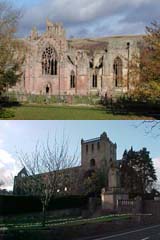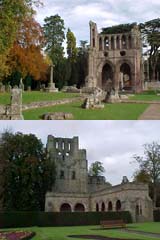Interest
Kelso Cricket Club
Kelso Cricket Club is the oldest club in Scotland founded in 1821.
The first formally recorded cricket match played in Scotland was
however in Alloa in 1785. The game is thought to have been introduced
to Scotland by the English soldier fighting in the Jacobite Uprisings
of 1715 and 1745.
Kelso Bridge
The present 5 arched bridge was the second built across the Tweed,
this being built between 1800 and 1803. The bridge was designed by
John Rennie and it became the model of the Waterloo Bridge over
the Thames. (built 1811 and demolished 1934)
 Border Union Showground
Border Union Showground
This is located on the SW of the River Tweed and directly on the
Borders Abbeys Way. The large showground is the home of the Border
Union Agricultural Society and they hold a variety of event on the
ground or in the large exhibition hall. Each July they hold their
annual show when visitors, locals and members flock to the showground.
To link to their website click on the logo.
To return to the History, Interest and News selection
click here.
Roxburgh Viaduct
This viaduct crosses the Teviot close to the village of Roxburgh.
This was designed by John Miller and constructed in 1847 and is
somewhat unusual in that the viaduct is built on a curve. There is a
suspended pedestrian bridge hung from the side this set up to give
residents of Heiton access to the village of Roxburgh.
To return to the History, Interest and News selection
click here.
Jedburgh
Uppies and Downies - Handba
This is a ball game played in the centre of the town between two
teams, the Uppies and the Downies. Its tradition is said to have
originated from the time of the Reformation when Scots were alleged to
play the game with the heads of slain Englishmen.
Redeswire Ride
This is an event held annually in July as part of the local common
riding. The horse riders head south towards the border with England and
attracts a large number of participants and followers. It is at Redeswire
that one of the Common Riding's most important orations is delivered.
Jeddart Justice
This is a terms developed from the medieval approach taken in the
town of hanging the person first and then holding the person,s trial later.
Jeddart Staff
This is a vicious weapon made up of a long pool with a long blade that is sharp and pointed. It was seen by the
enemies as being so frightening that the
Earl of Surrey said of the men of Jedburgh, "they are the
boldest men and the hottest that ever I saw in any nation".
The above image has been provided with permission from
The Borderers website.
To return to the History, Interest and News selection
click here.
Bedrule
In this small parish there is a ruined Castle destroyed in 1545
by the English along with the neighbouring church and village. Today's
church has a commanding view over to Ruberlaw and very early on Easter
Day the church conducts a service of worship at the top Ruberlaw. The
church has benefited from the generosity of Sir Robert Usher (local
Brewing family) and is worthy of a visit.
The village name is said to be Gaelic meaning 'The village by the
roaring stream'.
Mansfield Park
This is the home of the Hawick Rugby Football Club. "The Greens"
as they are known have been a long established, important and powerful
force in Scottish Rugby. The club started from the Hawick and Wilton
Cricket Club in 1872, becoming the Hawick Football Club in 1885 and
becoming the third border side to be admitted to the Scottish Football
Union in 1886. To see much more regarding this club and location visit
their website by
clicking here.
To return to the History, Interest and News selection
click here.
Textiles
Scotland's textile industry began in the early 18th century with
the introduction of the spinning wheel. Today Scotland is world-famous
for producing high quality tweed, tartan and cashmere as well as a
variety of knitted and cotton products.
The wool and cloth industry was underdeveloped before the industrial
revolution in 1770. By 1790 woollen mills were established in Hawick
and Galashiels.
The brightly coloured tartan cloth with which we are familiar today,
dates back to the 17th century but it was not until mechanisation that
clan tartans were introduced. Sir Walter Scott and the Royal Family made the
wearing of tartan very fashionable and even now we are seeing a
revival of this fashion.
Tweed, a hardwearing coloured cloth, was relatively unknown until 1830,
when it was adopted within the factory weaving industry. Border mills,
notably Galashiels and Hawick, acquired a worldwide reputation for
brilliance of design. The Scottish tweed industry additionally become
synonymous with quality.
Today the Scottish and Border textile industry is experiencing a number
of problems. The strong pound and rising yarn costs have made
exporting difficult and fashion has lately favoured lighter man-made
fibres. This has sadly resulted in the number of mills steadily
declining and some evidence of vacant old mills will be seen in Hawick
and Selkirk as the walker passes through.
To return to the History, Interest and News selection
click here.
Rugby Sevens
The Greenyards, the home of the Melrose Rugby Football Club, is also
the home of Rugby Sevens. This game was invented by Ned Haig in 1883
and was first played as a means of fundraising for the club. It has
now grown into a worldwide sport and the Greenyards still hosts an
annual tournament in April. (Ned Haig was born in Jedburgh but came to
Melrose and played rugby for the club in the 1880's. He was employed
in the town as a butcher.)
Eildon Hills
This triple peak range of hills to the SE of Melrose can be seen
from miles around and are both unique in their shape and legend. One
legend is that the Wizard Michael Scott split a single hill into three
under orders from the Devil. Another legend states that King Arthur and
his knights still lie under the hills, ready to emerge at a later date.
Yet a further legend related to Thomas the Rhymer.
These hill however were the location for a large pictish community
which existed prior to the Roman invasion of the area. When the Romans
arrived in the first century they established a signalling station on
the North Hill.
To return to the History, Interest and News selection
click here.
Thomas the Rhymer
Thomas the Rhymer, or Thomas Learmont, was a 13th century poet and
seer who lived in Erceldoune, now known as Earlston.
Legend has it that whilst out walking the Eildon Hills, Thomas fell
asleep for what seemed to him like a few minutes but was in fact three
years. During this time, he was spirited away by the Queen of Elfland
to be her lover. His reward was her gift to him of prophesy as she
releasing him back into the mortal world. Thomas then went on to use
his elf-given powers by predicting several significant events in
Scotland's history. These included:
- The death of King Alexander III in 1296
- The succession of Robert the Bruce to the throne
- The disastrous Scots defeat at Flodden in 1513
- The defeat of Mary Queen of Scots' forces at the Battle of Pinkie in 1567
- The Union of the Crowns in 1603
1603 was also the year in which his prophesies were collected together
and published in print. His story is told in the ballad of "Thomas
the Rhymer" which Sir Walter Scott included in his collection
"Minstrelsy of the Scottish Border".
Thomas himself is also believed to have been the author of
"Sir Tristrem", edited by Scott and reputedly the oldest known
piece of Scots poetry.
To return to the History, Interest and News selection
click here.
Wallace Statue
A short distance off the Way this impressive sculpture stands overlooking the Tweed River and out towards the
Eildon Hills and over St Boswells towards the Teviot Valley.
The Statue is to commemorate William Wallace, The Knight of Elderslie, who won the Battle of Stirling Bridge in 1297. This
was the first statue of William Wallace and was commissioned by the 11th Earl of Buchan in 1814 along with the Urn that
bears the incription shown below. The earl was also responsible for the creation of the Temple of the Muses which is
situated at the riverside and on the Borders Abbeys Way just next to the east end of the pedestrian bridge.
William Wallace has in more recent times become better known throught the award winning film "Braveheart".
|
 |
 |
First view up at the Wallace Statue |
Plaque detailing the engraving on the Urn |
Urn positioned below the statue |
 |
 |
 |
Path leading up to Wallace Statue |
Wallace Statue which looks west |
View from the Statue to the Eildon Hills |
To reach this statue break from the Borders Abbeys Way at the road junction next to the entrance to
Dryburgh Abbey Hotel. Walk uphill on the road out of Dryburgh for about 100 metres before turn left
onto a narrow waymarked path. There is now a woodland walk constantly ascending that will take you to
the base of the Statue. Allow between 15 to 20 minutes for this diversion from the junction.
For a map showing you the position of the Statue and the line of the Borders Abbeys Way link to
streetmap.co.uk/map.srf?X=359202&Y;=632712&A;=Y&Z;=115.
This page is seen as being dynamic and we hope that new items will be introduced with time.
If you wish to input to this section please send us details using the
following link.
|









